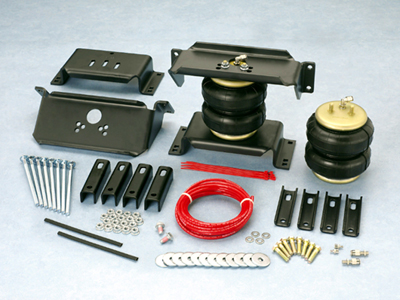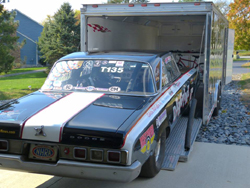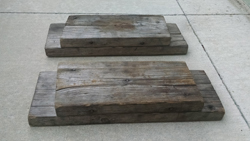| |
| Basics
of Proper Trailer Towing |
(More
tech articles on the Tech, Tests & Installs page
HERE)
 Racers,
we all log a lot of miles transporting ourselves and
our cars to the dragstrip on a weekly basis. This
is no small task but many of us take it for granted.
Think about it: we’re not only driving a vehicle,
but that vehicle is towing another vehicle that’s
carrying yet another vehicle. Then think about how
many knucklehead drivers we encounter on a daily basis
when we’re driving our regular cars. It’s
bad enough having to take evasive action when driving
a daily driver. It’s even worse when we’re
driving a loaded trailer. Having a properly equipped
and loaded trailer won’t prevent any encounters
with knucklehead drivers, but it can change the outcome
from being catastrophic to being a minor annoyance.
Proper towing means having the right equipment, knowing
how to load and employing safe drive habits. Let’s
look at the loading first. Racers,
we all log a lot of miles transporting ourselves and
our cars to the dragstrip on a weekly basis. This
is no small task but many of us take it for granted.
Think about it: we’re not only driving a vehicle,
but that vehicle is towing another vehicle that’s
carrying yet another vehicle. Then think about how
many knucklehead drivers we encounter on a daily basis
when we’re driving our regular cars. It’s
bad enough having to take evasive action when driving
a daily driver. It’s even worse when we’re
driving a loaded trailer. Having a properly equipped
and loaded trailer won’t prevent any encounters
with knucklehead drivers, but it can change the outcome
from being catastrophic to being a minor annoyance.
Proper towing means having the right equipment, knowing
how to load and employing safe drive habits. Let’s
look at the loading first.
Proper
Loading
Your ability to handle and control
your tow vehicle and trailer is greatly improved when
the cargo is properly loaded and distributed. Load
your trailer heavier in front: the trailer should
have about 60% of the cargo weight in front and 40%
in the back. This is pretty easily accomplished in
the case of hauling a door car where the engine is
in the front. In the case of hauling the typical rear-engine
dragster, care should be taken to add some more cargo
to the front of the trailer to get to that 60%.
Refer
to your tow vehicle and trailer owner’s manuals
to find out how to balance weight from side to side,
distribute cargo weight evenly along the length of
the trailer, adjust the height of the tow vehicle/trailer
interface, and apply load leveling (weight distributing
hitch bars).
The
Right Equipment
Racers, I’ve seen some stupid things in my time
going to the track. I used to tow the Dodge with my
1998 Jeep Grand Cherokee (it also doubled as my hotel
which I referred to as The Cherokee Grand). I was
towing the Dodge on an open car carrier and I was
always under the towing limits of the Jeep. However,
I’ve witnessed a Jeep like mine hauling a box
that had to be at least 24 ft. What was that guy thinking?
If the box had anything in it, it was way beyond the
capacity of that Jeep, and one good gust of wind would
send the whole rig off the road. I now tow the Dodge
in a 24 ft. box with a 2500-series ¾-ton Chevrolet
Suburban which is maxed for towing: 8.1 liter engine,
4.10 gears, extra cooling, and heavy duty suspension.
 Suspension
is a key component to safe towing. More specifically,
a fully-functioning suspension system (meaning having
the ability to travel as designed) is crucial to safe
towing. Trailers and tow vehicles should be level
(parallel to the ground) during travel. To learn more
about this, I spoke with Todd Green, Sales
Manager at Firestone Ride-Rite,
which manufactures air-ride systems for tow vehicles
like ours. That's a Ride-Rite system pictured. States
Todd, “When vehicles are towing and the rear
is sagging, the weight of the trailer decreases the
suspension travel which reduces the ability for the
suspension to compensate for road conditions. When
this happens the suspension cannot perform at its
best. OE suspensions are a compromise between comfort
and capacity. Cheat the system by adding an adjustable
air helper spring system and get the full potential
out of your tow vehicle. Bringing the suspension back
up to the designed height with a kit like Ride-Rite
will allow the suspension to cycle normally, distribute
the load and reduce suspension fatigue.” There
are other benefits to having a properly level rig.
Says Todd, “Our air suspension kits will reduce
bottoming out, reduce sway, improve braking effectiveness
and level your headlights.” I hadn’t thought
of the headlights, but when Todd said that, a lightbulb
went off in my head. How much do we hate driving toward
someone who’s headlights are angled right up
to us? I don’t want to be that guy! Suspension
is a key component to safe towing. More specifically,
a fully-functioning suspension system (meaning having
the ability to travel as designed) is crucial to safe
towing. Trailers and tow vehicles should be level
(parallel to the ground) during travel. To learn more
about this, I spoke with Todd Green, Sales
Manager at Firestone Ride-Rite,
which manufactures air-ride systems for tow vehicles
like ours. That's a Ride-Rite system pictured. States
Todd, “When vehicles are towing and the rear
is sagging, the weight of the trailer decreases the
suspension travel which reduces the ability for the
suspension to compensate for road conditions. When
this happens the suspension cannot perform at its
best. OE suspensions are a compromise between comfort
and capacity. Cheat the system by adding an adjustable
air helper spring system and get the full potential
out of your tow vehicle. Bringing the suspension back
up to the designed height with a kit like Ride-Rite
will allow the suspension to cycle normally, distribute
the load and reduce suspension fatigue.” There
are other benefits to having a properly level rig.
Says Todd, “Our air suspension kits will reduce
bottoming out, reduce sway, improve braking effectiveness
and level your headlights.” I hadn’t thought
of the headlights, but when Todd said that, a lightbulb
went off in my head. How much do we hate driving toward
someone who’s headlights are angled right up
to us? I don’t want to be that guy!
I
asked Todd if there were a particular Ride-Rite system
that’s especially easy to install. He replied,
“Ride-Rite™ Air Helper Springs. They are
a simple “bolt in” no-drill solution for
towing and hauling. When installed correctly and properly
maintained a Ride-Rite kit should last the lifetime
of the vehicle. Kits are made to fit a specific make,
model, and year.” Here's a video that details
a Ride-Rite No-Drill Kit installation.
Another
area of equipment that should never be compromised
is the tires. Most trailers that I’ve used have
come with Load Range D tires specifically for trailer
service. When it comes time to change them, do yourself
a favor and switch up to Load Range E. Everything
in our world (meaning our race cars) is literally
riding on the tires, so inspect them regularly for
dry rotting and the dreaded sidewall bubble. When
it comes time to replace, step it up to Load E tires.
Also, always check your pressures. To get full load-carrying
ability, tires need to be inflated to their maximums,
but don’t go over. That leads to poor handling
and premature wear.
Driving
Habits
Racers, I’m sure we’ve all seen it: other
racers rushing to get to the track, passing us on
the highway with their rigs, obviously well-exceeding
the speed limit. Just slow down! Keeping your speed
reasonable makes for a safer trip and puts less heat
in the tires. The likelihood of trailer-sway also
increases at higher speeds. If you do get sway, activate
the trailer brakes by hand with the brake controller,
but do not also activate the tow vehicle brakes. To
control swaying caused by air pressure changes and
wind buffeting when larger vehicles pass from either
direction, release the accelerator pedal to slow down
and keep a firm grip on the steering wheel.
Pre-Departure
Safety Checklist
-
Check
and correct tire pressure on the tow vehicle and
trailer.
-
Make
sure the wheel lug nuts/bolts on the tow vehicle
and trailer are tightened to the correct torque.
-
Be
sure the hitch, coupler, draw bar, and other equipment
that connect the trailer and the tow vehicle are
properly secured and adjusted.
-
Check
that the wiring is properly connected— not
touching the road, but loose enough to make turns
without disconnecting or damaging the wires.
-
Make
sure all running lights, brake lights, turn signals,
and hazard lights are working.
-
Verify
that the brakes on the tow vehicle and trailer are
operating correctly.
-
Check
that all items are securely fastened on and in the
trailer.
-
Be
sure the trailer jack, tongue support, and any attached
stabilizers are raised and locked in place.
-
Check
load distribution to make sure the tow vehicle and
trailer are properly balanced front to back and
side to side.
-
Check
side- and rear-view mirrors to make sure you have
good visibility.
-
Check
routes and restrictions on bridges and tunnels.
-
Make
sure you have wheel chocks and jack stands
|
Before
Heading Out For A Long-Distance Tow |
 Wherever
you live and whatever track you race for, if you’ve
had a good season in either NHRA or IHRA ET bracket competition,
you’ve secured a spot on your track’s team and
will be going to do battle with the best of the best of all
of the tracks in your division. Some of you might have a long
tow ahead of you, and some of you might not be used to towing
for long distances. Before you take to the road, here’s
a handy check list to refer to before heading out. Wherever
you live and whatever track you race for, if you’ve
had a good season in either NHRA or IHRA ET bracket competition,
you’ve secured a spot on your track’s team and
will be going to do battle with the best of the best of all
of the tracks in your division. Some of you might have a long
tow ahead of you, and some of you might not be used to towing
for long distances. Before you take to the road, here’s
a handy check list to refer to before heading out.
- First,
always have a spare trailer tire, and if possible
carry two spares. If you have a blowout of a trailer tire
and you use the spare, then you’ll be completing
your trip with no additional spare. Another issue is the
remaining tire that was on the same side as the blowout
may have taken a lot of abuse when it had to support all
of the weight on that side by itself. It’s possible
the tire has been compromised. When it comes time to replace
the tire that blew out, you should replace the other one
at the same time. Make sure that when you check the tire
pressures on the truck and trailer before hitting the
road, you also air up the spare. If it's been sitting
for a while, it's likely not inflated enough to last very
long while carrying a heavy load.
 If
you do have a blowout on your trailer,
the easiest way to get that tire off the ground is to
drive the good tire up onto a ramp. I keep two ramps I
made of wood in my tow vehicle (pictured). If
I do blow a tire, I put the ramps on both sides of the
trailer and drive it up evenly. You’ll want to break
the lug nuts loose before getting the flat tire off the
ground. If
you do have a blowout on your trailer,
the easiest way to get that tire off the ground is to
drive the good tire up onto a ramp. I keep two ramps I
made of wood in my tow vehicle (pictured). If
I do blow a tire, I put the ramps on both sides of the
trailer and drive it up evenly. You’ll want to break
the lug nuts loose before getting the flat tire off the
ground.- Go
to your auto parts store and stock up on emergency road
flares to use if you need to pull over on the
side of the road. Also pick up a tire plug kit.
Not all flats are blowouts. Many are punctures from a
nail or screw that are easily repaired with a rope plug.
You can then air the tire back up using the portable compressor
you keep in your trailer to air up your slicks. Don’t
have one? Time to get one!
- Give
your tow vehicle an oil change, and if possible
new transmission fluid. A little bit of cheap maintenance
can go a long way toward keeping your rig happy and healthy.
- If
you’re traveling a long distance to get to your
bracket finals, you may find yourself parking your rig
in a hotel parking lot
on the way to and from the event (when you’re at
the event, you’ll likely unhook the trailer and
leave it at the track as you go back and forth to the
hotel). This brings up the questions of security. How
much would THAT stink to go out to the parking lot the
next morning to find an empty spot where your truck, trailer
and race car were parked. A good insurance policy is a
trailer security system like the Pro-Tec
System One from Trailer Alarms LLC,
which monitors and protects the trailer and its contents.
Any movement of the trailer, or the opening of a door
will trigger the alarm. This will cause the electrical
brakes of the trailer to be applied making movement impossible
in addition to exterior alarms alerting the public.
Last
but not least, know your loaded weight! Take your fully
loaded trailer to a weigh station or scrap yard with a scale
and find out how much you’re really towing. Good luck
and safe travels. |
Sources:
Firestone Ride-Rite
www.EliminateRoadWince.com
Trailer
Alarms, LLC / Pro-Tec System One
www.Trailer-Alarms.com
National
Highway Traffic Safety Administration
www.nhtsa.gov
|
|
|
|
|
|
|
|
|
|
|
|
|
Dragtime
News On Location |
Tech,
Tests & Installs |
Bracket
Racing 101 |
|
|
Visit
the Tech,
Tests & Installs main page. |
Visit
the Bracket
Racing 101 main page.
|
|
|
|
|
|
|
 |



